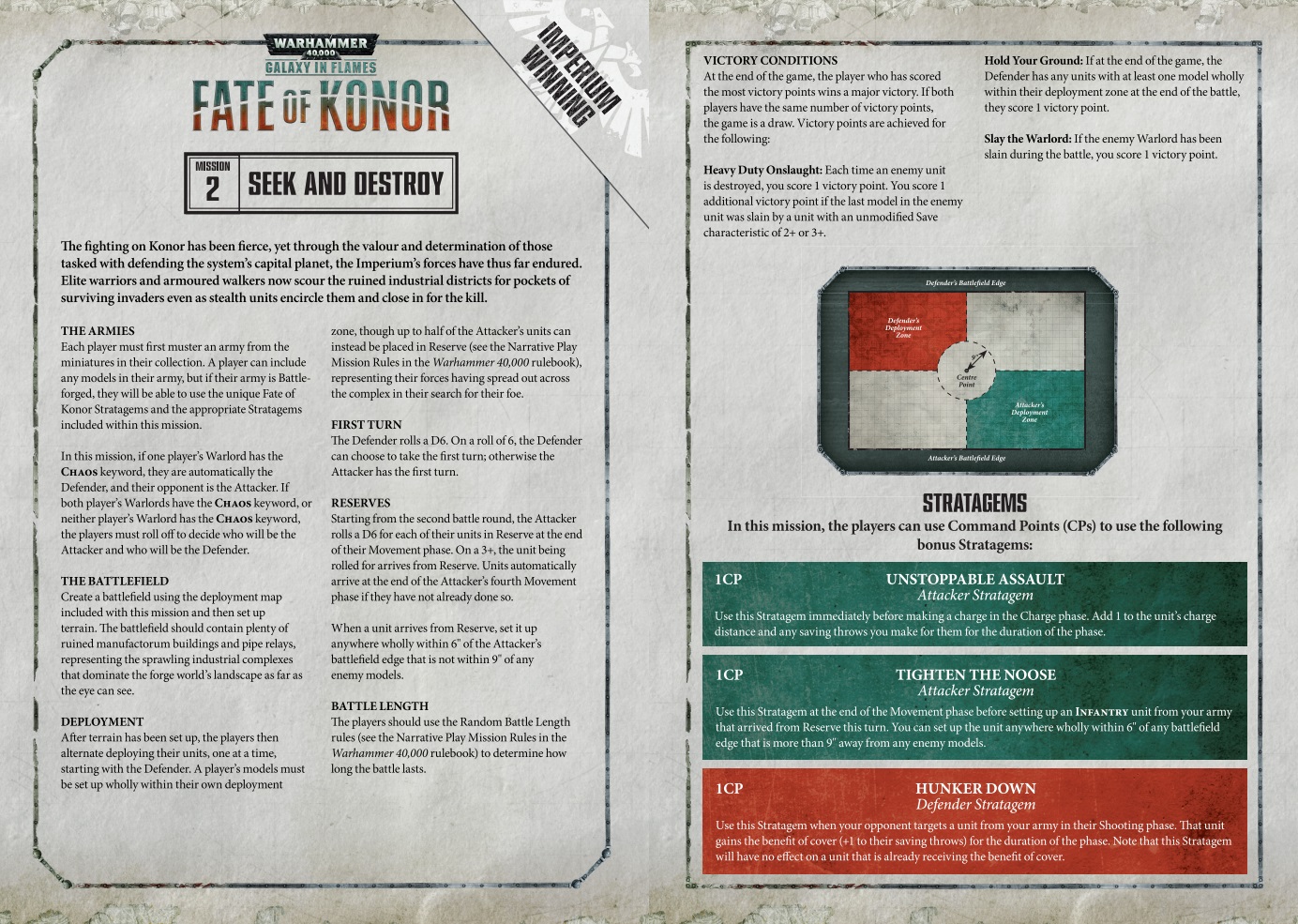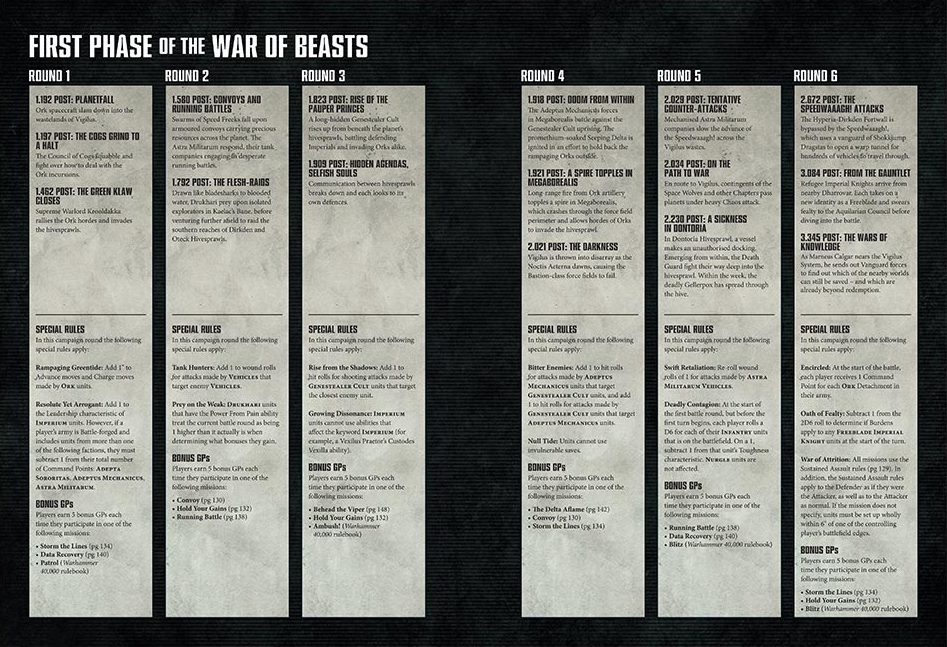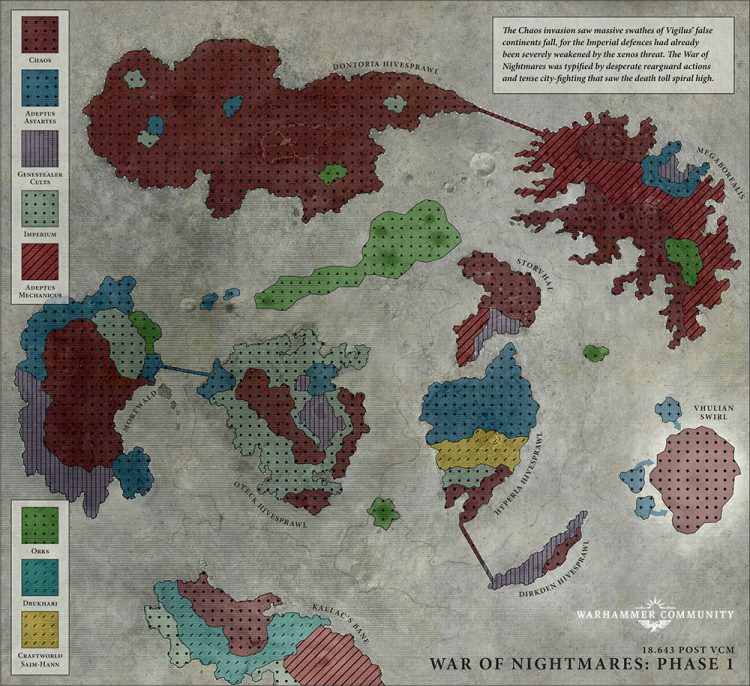The Warhammer 40,000 universe is a massive place, and the “Narrative Forge” hobby articles encourage thinking outside the box (literally) when putting models together and stretching yourself out in the hobby. They aim to make hobbyists and players comfortable growing beyond imitating the models they see in their Codexes and playing the rulebook missions, and serve as a source of inspiration for anyone wanting to forge new experiences in the hobby. This week, Robert “TheChirurgeon” Jones is continuing his multi-part series on creating and running campaigns. This week, he’s talking about Mass Campaigns.
In our last article, we explored building and running a Tree Narrative campaign. Then we took a week off to talk about making your own missions. Today we’re back on the topic of campaigns, and specifically looking at Mass Campaigns, or campaigns designed to run with many players.
Mass Campaigns
Up to this point, we’ve focused on smaller campaigns that follow a set narrative and work best with two players or two small teams of players. They need everyone playing each round, and the focus is on playing specific games that advance the plot. But what if we want to play a large campaign, with more than a dozen players? At that point, the complexities and realities of life and the logistics of scheduling become much more cumbersome, and keeping things moving may be difficult if the narrative depends on any one player. At this point, we need a campaign type that can handle large groups of players working on different schedules and with different time commitments to the campaign. Enter the Mass Campaign.
Mass Campaigns were first introduced into the Warhammer popular consciousness with the Shadows Over Albion campaign for Warhammer Fantasy Battles and the Eye of Terror campaign for Warhammer 40,000. Although 40k had previously run a mass campaign for Armageddon, Eye of Terror was a smash success and did more to popularize the notion, with its custom website and campaign map, and the opportunity for players to allocate wins to specific planets. In a mass campaign, the campaign is divided into a number of rounds, where battles taking place each round count toward some outcome, depending on who wins and who loses and what side they’re on. During rounds, players schedule games and play them normally, then report the results of those games to the campaign organizer, and score points based on those results. At the end of each round, the total points earned by each side (or allocated to each goal) are tallied up, and the side/goal with the highest score wins, potentially scoring a bonus for the winning side, or altering the narrative for the next round, or having some other mechanical effect.
Why Run a Mass Campaign?
- You have a lot of players. Mass campaigns work very well when you have a dozen or more people who want to get games in, where doing matchmaking each round will become a real pain and trying to have everyone play every game just isn’t feasible.
- You want something that feels grand in scale. The cool part about Mass Campaigns is that the large player count makes it feel like everyone is taking part in a series of larger battles with constant war overtaking the planet. While it can diminish the role any one player has in the overall story, the story itself feels bigger, and that can be a plus.
- You don’t have a lot of time to spend on GM stuff. Mass campaigns require a lot of GM set-up work, but not a ton of time once they’re going. If you plan things right, people can do their own scheduling and matchmaking, and then you just have to handle reporting results.
- You want to keep things open-ended. With a mass campaign, creating bonuses and incentives is pretty easy, and you can easily make players feel involved without having to give each one a bespoke story — let them build the story on their own. You can also easily pivot from round-to-round, and don’t have to lay things out too far in advance for your players. But you should still keep a clearly-defined end in mind.
Consider a Mass Campaign If: You have a lot of players. I mean really once you get past 8 players, your options for what will feasibly work become really limited, really fast.
Although designed for many players, Mass campaigns tend to work best when players can be segmented into two sides or teams, but can be made to accommodate more, particularly if the number of players per side can be kept relatively even.
So far, 8th edition has had three Mass Campaigns, one of which was publicly run and the other two are published campaign systems. Today I’m going to talk about all three. The first was the Fate of Konor campaign.
The Fate of Konor Campaign
Fate of Konor was a mass campaign run by Games Workshop shortly after the launch of 8th edition, focusing primarily on the conflict between the Imperium and Chaos, with a major focus on the Ultramarines and Death Guard. Konor is a system in the Ultima Segmentum, and placed under siege by Mortarion’s forces. The campaign ran over 6 weeks, with each week representing the battles that would decide the fate of a different planet in the Konor System. There was a lot going on in this campaign, which included a custom website that sadly, is no longer up.
In addition to a new planet to fight over each week, players were also given a custom mission to play and report results against. These missions would have an attacker and a defender, and custom stratagems for each. These weekly battles would also emphasize specific unit types that Games Workshop was trying to encourage players to build and paint, which added a type of slow-grow/escalation element to the campaign. After a player played their game – which had to be at a Games Workshop store – the results were recorded, with specific factions working toward an Imperial victory, and others toward a Chaos victory.

Ultimately, the Konor campaign ended in a 4-2 Imperial victory. It’s an interesting case study and an easy example of how you can create and run your own mass campaign: Start by setting the narrative stage, pick the number of rounds and how long each will last, and then each round, give your players a mission to go play. You’ll want to determine how many times players can do the same mission, and whether there should be diminishing returns for playing more games, but overall you just need a list of planets and a list of missions to get started. I recommend using an odd number of planets however, just so you can create a clear victor and avoid ties.
The Vigilus Campaign
Although not a worldwide campaign run by Games Workshop to determine the fate of the planet, the Vigilus Campaign books – Vigilus Defiant and Vigilus Ablaze – contain a very cool mass campaign system for running battles to determine the planet’s fate, and allow for players from almost every faction to participate, with some interesting rewards for players who tackle scenarios or missions that are relevant to the round.
Vigilus Defiant: The War of Beasts
The War of Beasts covers the first half of the Vigilus campaign – basically before Abaddon’s forces show up en masse – and comes in three phases. Each phase is split into six rounds, where players from all factions can compete in games to determine a victor – note that these are side-based, so you can play any mission and your victory counts for your side. Each round also has special rules that apply to games played in the round and usually reflect the battlezones, factions involved in the narrative, and the conditions affecting the battle. They also create opportunities for bonus campaign victory points (called “Glory Points”) if players play specific missions from the Vigilus book, so missions that reflect where the fighting is most intense and the most important battles are happening.

This creates a solid structure for an 18-round campaign that can handle 12+ players and on multiple teams. You’ll ideally want teams to have roughly the same number of players each, but you can get away with having more than two teams though ideally the number of teams you have is also even. In addition to scoring points for winning games and the bonus points each round, players score bonus points for using Vigilus battlezones and playing Vigilus missions.
Vigilus Ablaze: The War of Nightmares
The second half of the Vigilus campaign adds another 3-round campaign called The War of Nightmares, which sees the forces of Chaos starting their massive incursion to the surface of Vigilus. The same mechanics apply this time, with players able to play any games they want each round, but then scoring bonus GPs for taking on specific battlezones and missions that represent key moments and battlefields of import during the campaign. In several places, it also refers back to Vigilus Defiant, which is a neat touch when it needs a specific battlezone.

Creating Your Own Mass Campaign
Ok, we’ve seen a couple of different approaches to mass campaigns, time to create our own. Let’s go back to the basics, here’s what we need:
- The Narrative. Don’t forget, you need a story to tie everything together. Mass campaigns make it much easier to handle players with lots of different armies and factions, since you can just have everyone fighting for themselves or loosely in uneasy alliances. The downside is that your narrative will more likely resemble a boring “everyone’s out to get Curly’s Gold” or “just control the planet” story, where the key story beats are more the missions themselves.
- Players and Teams. While you don’t have to split your players into teams, having teams makes things easier. If you don’t have teams for players to play for each round, then instead you can replace those with goals. Rather than having a round go to the winning team, the round can be something like “forces on Grandor IV are fighting over the geothermal lava dams that provide power to the northern continent’s largest hive city. Choose whether you are fighting to protect or destroy the dam.” In this case, the players choose which goal to play for each round rather than a specific team, and score points for wins and meeting bonus goals all the same. At the end of the round, the goal with the most wins toward it wins and affects the narrative in the next round. Now the southern fields are flooded with lava, creating lava field battlezones in the next round and the hive has lost power, leading to riots and looting and lowering the defenses, so players may fight over the hive in Cities of Death games in the next round as well.
- The Round Structure. You’re going to need to identify how many rounds players will play and the framework they’ll be playing them in. How long is a round, time-wise? How many games can a player play each round counting towards the result or their points total? Do they need to play a specific mission?
- Scoring. How much is a win worth, and are there bonus points? You’ll want to put a scoring rubric in place so players know what they have to do to win.
The good news is, once you have these things, you’re pretty much good to go. Mass campaigns are really about giving your players freedom to play and schedule their games according to what they’re able to do, so you aren’t
Other Things You Can Add
If you’re looking for more spice or ways to make things matter during your Mass Campaigns, consider some of the following:
- Major Event Games. Not every game or round has to be just letting players pick their own opponents and missions. You can have special event games in a round that allow multiple players to participate and score points for their side. This is a great way to do megabattles, where everyone brings 500 points, or games of Apocalypse, that represent major conflicts going on during a given round, while players still play their own games with each other outside of that game. You can set these up so that they score more points the more players are involved, allowing players to take part in a big, communal game but without punishing the players who can’t participate.
- Event Cards. Something the Eye of Terror campaign did that was pretty neat was award players special event cards for winning key games. Players who win key games or score the most points in a round might be given a card that can have a major impact on the story, or give their side a key advantage at an important time. These can add a layer of strategy to the game but don’t give away too many of them–you want them to be very special when they happen. They’re a good reward for the MVP of the winning side in a major event game.
- Escalation. We’ll talk about Escalation Leagues more next time, but there’s nothing stopping you from combining one with a campaign like this, to represent massing forces over a long period of time.
- Other Systems. Because Mass Campaigns can be very fluid in how players are asked to play, you can also allow players to play games of Kill Team or Apocalypse for their games in a given round, and create bonuses or missions for them to play if they do. It’s an easy way to allow them to pick the scale of their engagements.
- Narrative Hooks. Just because the broad narrative is “everybody is fighting” doesn’t mean you can’t inject some narrative into the campaign’s rounds as well.
Next Time: Escalation Leagues
That wraps up our look at Mass Campaigns. Hopefully you’ve got what you need to build and run one of your own. Next time we’ll look at Escalation Leagues, where players are given progressively larger armies to work with each round. As always, if you have any questions, comments, or feedback, feel free to drop us a note in the comments below or email us at contact@goonhammer.com.



